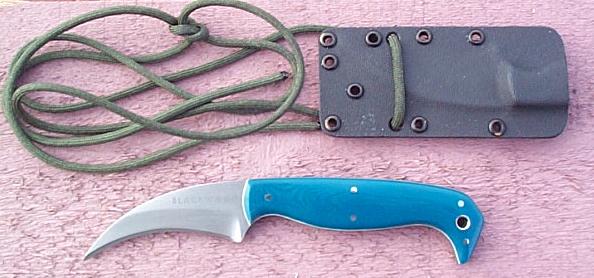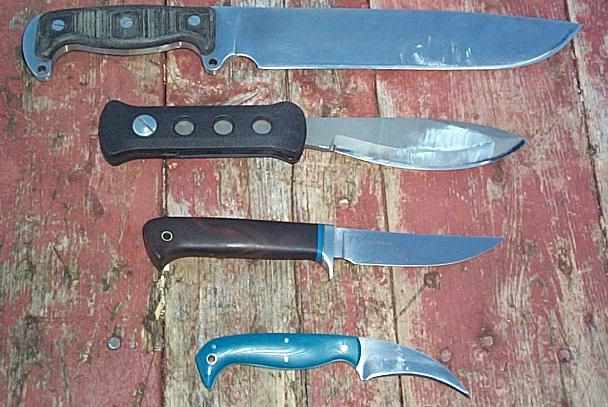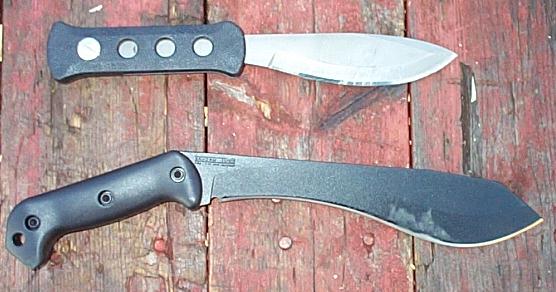
This was a custom design based on an existing larger Hawkbill. It was made by stock removal out of 1/8" D2 and includes a cryogenic quench as part of the heat treatment to a uniform 60 HRC. The primary grind is sabre-flat with a secondary v-ground edge bevel. A striking handle color was chosen mainly to reduce the "weapon" type signature that such knives tend to produce. It came with a Kydex neck. Image :

The scales were flush to the tang and the handle swelled nicely in both directions enhancing comfort and security. It was custom ground to my hands, sent dimensions to Blackwood. The grind lines are even and symmetric, everything is nice and radiused, no sharp grind transitions and the knife came highly polished and shaving sharp. The sheath is well built and securely holds the knife without being too tight that it inhibits drawing.
The only negative finish wise was a few slight scuff marks on one side of the flat above the primary grind, nothing severe.
Through cutting weeds, cardboard and other light work the Hawkbill fared well as compared to a light utility knife made by Mel Sorg. In many situations the power of the Hawkbill curve was significant as the blade would lock onto the material being cut and eliminated slipping. Even when the blade was severely cull by running the edge over concrete the knife was much more effective cutting ropes and such that a straighter edge profile.
The very low and narrow point was very useful for precise work such as opening boxes and dismantling them by running along seams. It also protects the edge and allows cuts on very hard materials. For example the Hawkbill's point had no trouble cutting rubber tubing off of metal fittings, the only part of the blade that touched the metal was the actual point it could quickly cut the tubing with only minimal blunting to the very tip. This can be done with more traditional blades such as drop points, but forces a much less comfortable wrist position.
However the extreme geometry does reduce the overall functionality as a lot of cutting becomes difficult if not impossible. For example trying to do food preparation on a cutting board is difficult, and the point has little presentation for any stabbing, prying or digging as it is perpendicular to the spine. Plus if really wide material has to be cut the blade loses efficiency as the blade then presents a concave profile to the cut which lowers performance significantly.
The handle was decently comfortable during all work however was a little slippery. The grip could also be a little thicker to increase comfort during really heavy cutting. Of course a really thick handle would make concealing a neck knife fairly difficult. The striking blue handle also did little to reduce the very strong "weapon" reaction from some people.
To get some numbers for the relative push cutting ability points were made on on pieces of Pine scrap which was from one to two inches in thickness and one to three inches in width. The points were equally split between one and two inches in length. Various blades were used to give a relative performance ranking of the Hawkbill and to examine the influence of the various geometrical aspects. A shot of some of the blades used :

Battle Mistress, P.J. Turner Bolo, Coyote Meadow and Blackwood Hawbill. The others :

Turner Bolo and Machax. Specifications for the knives :
| Model | Edge | Blade | Distance to cut | |||
|---|---|---|---|---|---|---|
| Angle | Width | Type | Profile | Taper | ||
| Hunter | 15 | 0.016" | flat | straight | yes | 1.0" |
| Battle Mistress | 16 | 0.075" | dual | straight | no | 1.8" |
| Bolo | 19 | 0.115" | convex | convex | no | 1.4" |
| Hawkbill | 18 | 0.055" | flat | concave | no | 0.4" |
| Machax | 24 | 0.070" | flat | concave | no | 1.0" |
Distance to cut refers to the distance from the center of the index finger to the start of the sharpened edge. This is critical for such cutting as it directly controls leverage, the longer this length the more work that has to be done to make a given cut. The angles are just estimates for the convex profiles, they are the flat angle of the same thickness and width.
The cutting was done at full force, with both a light and high volume of wood cut to look at fatigue. The high volume runs were through a volume of wood three times larger than the low volume runs. The cutting ability was measured in both number of cuts as well as time to examine both raw penetration ability as well as overall efficiency. The results :
| Model | High volume | Low volume | High volume | Low volume |
|---|---|---|---|---|
| Cut Ranking | Time Ranking | |||
| Hunter | 100 | 100 | 100 | 100 |
| Battle Mistress | 47 (2) | 44 (6) | 47 ( 7) | 78 ( 7) |
| Bolo | 36 (2) | 43 (7) | 48 (10) | 80 (15) |
| Hawkbill | 30 (1) | 39 (4) | 44 ( 7) | 67 (10) |
| Machax | 18 (1) | 18 (3) | 23 ( 3) | 39 ( 5) |
No surprises about first and last place two blades stand out readily due to the extreme geometries used. The light utility hunter has the most slim and acute edge and a small torque disadvantage where as the Machax has the thickest and most obtuse edge. The table also shows that the lower the rank the more the loss is seen when going from low to high volume which is easily understood as there is fatigue induced on the lower performing blades as they have to do more work. It is also clear that the time rank reduces the lead of the top blade as the deeper cuts take more time to make.
For the high volume rankings some comments are necessary. The light utility hunter was used at full force and cut well enough so that no significant fatigue developed. The Battle Mistress was used at a smooth pace under maximum, the Hawkbill was used at full force, and the Bolo in between. Thus the relative cut rankings improves for the Battle Mistress over the Bolo and Hawkbill as with those blades could cut little wood towards the end of the cutting due to greater fatigue, however the time rankings are near identical as the quicker starts with the Bolo and Hawkbill make up for the inefficiency near the end. The time ranking for the Machax dropped so much because the fatigue rate was excessive and actual breaks had to be taken.
Of course many factors like the length of the cut, the force used and the type of wood will all effect the performance of the various blades. However in general these variations don't change the order rankings. For example in another such comparison a harder wood was used and less force was applied during the cut. Since this meant that the cuts were more shallow, the thick primary grind of the Machax was less of a drawback and its relative performance was higher [ref].
The steel being D2 at 60 RC stays sharp for an extended period of time. After cutting most materials, steeling raises the performance somewhat, but a fine ceramic or diamond rod proved much more effective. Large bench stones and most clamp and rig systems would be problematic due to the extensive curvature. After half a dozen such touch-ups a slightly secondary bevel developed which was removed with a couple of small DMT folding hones.
UPDATE : after discussing with Neil some possible modifications he offered to make a replacement so this knife was not subjected to any extended durability or edge retention work.
Being light and thin, the blade does not print strongly and is quickly forgotten with neck carry. The drawing is a bit cumbersome however. If worn under a shirt it is far more awkward than a pocket folder or belt knife. If worn outside it tends to flop around too much.
Comments can be sent to : cliffstamp[REMOVE]@cutleryscience.com . Feedback can also be seen in the following ARCHIVED thread on Bladeforums :
Neil Blackwood can be contacted via email and has a website you can visit for more
information on his knives.
| Last updated : | Mon May 12 10:45:00 NDT 2003 |
| Origionally written : | Wed Jun 7 14:02:50 NDT 2000 |